HUNTSVILLE – The University of Alabama in Huntsville has developed a cybersecurity software for the U.S. Army Space and Missile Defense Command, the university announced today.
The software began performance testing on one of Lockheed Martin’s In-space Upgrade Satellite System (LM LINUSS) technology demonstrator CubeSats. The software, Small Satellite Defender, is an intrusion detection system designed for small satellites.
The Small Satellite Defender – created by UAH students, UAH Center for Cybersecurity Research and Education (CCRE) staff and SMDC cybersecurity engineers – will continue to run for several weeks collecting data and periodically transmitting data to the ground station. The students are members of the Space Testing and Resiliency Simulation team (STARS), who perform small satellite research and development for USASMDC.
“We are extremely proud of our students. Originally, they wrote the software and completed it for SMDC, and then Lockheed Martin approached us to collaborate with their LM LINUSS program,” said Dr. Tommy Morris, director of the UAH CCRE. “Our students restructured their code to run on LM LINUSS, passed tests on a Lockheed Martin laboratory model and developed an in-flight test plan with Lockheed Martin engineers.”
The Small Satellite Defender runs with relatively low power, monitors for satellite specific threats and requires very low bandwidth. The software is collecting data for multiple weeks and periodically transmitting the cyber status to the ground station. The initial test results indicate the Small Satellite Defender software performed as intended, and the application passed all in-flight tests.
Lockheed Martin began on-orbit operations in early 2023 with the LM LINUSS CubeSats. The internally funded satellite system was part of Lockheed Martin’s mission to validate essential maneuvering capabilities through rendezvous and proximity operations for future space upgrade and servicing missions.
“We are thrilled that LM LINUSS is being utilized above and beyond its original mission objectives, which demonstrates how Lockheed Martin is leading innovation by reconfiguring satellite missions on-orbit,” said Bob Behnken, Lockheed Martin’s director of Technology Acceleration for its Ignite organization. “We are proud to partner with UAH to provide this unique STEM opportunity for their students and to help strengthen cyber resiliency.”
UAH is a member of the SMDC’s Underserved Community Cybersecurity and Engineering Educational Development initiative, known as SUCCEED. The program began as a joint initiative between SMDC and UAH to create a talent pipeline and reach students at underserved high schools and universities across the state and beyond.
“Our students are leading the way for cybersecurity research and development programs. Their agility and knowledge allow for greater collaborations such as this with our industry and government partners,” said UAH President Dr. Charles L. Karr. “UAH is pleased to see our graduates also engaging in cybersecurity initiatives around the state. On the project alone, there were UAH alumni working for SMDC. We congratulate our students and graduates working in cyber.”
The state of Alabama is working to strengthen its STEM workforce. Through various technology initiatives, universities across the state are encouraged to create a conduit to the industrial base. Cybersecurity engineering is one of the major priorities.
“Recruiting, retaining and expanding 21st century jobs in Alabama requires us to encourage future generations of workers who are well-trained in the STEM pathways,” said Lt. Gov. Will Ainsworth. “UAH’s Small Satellite Defender on-orbit demo, enabled by Lockheed Martin’s LM LINUSS, is a key tool in developing those skills and is one of the early successes in our statewide initiative called Strengthening Alabama’s Critical Infrastructure Resiliency, which is known by the acronym SACIR.
“The technology sector is an important bedrock in Alabama’s economy, and these programs help ensure it remains healthy,”
Don’t miss out! Subscribe to our email newsletter to have all our smart stories delivered to your inbox.



